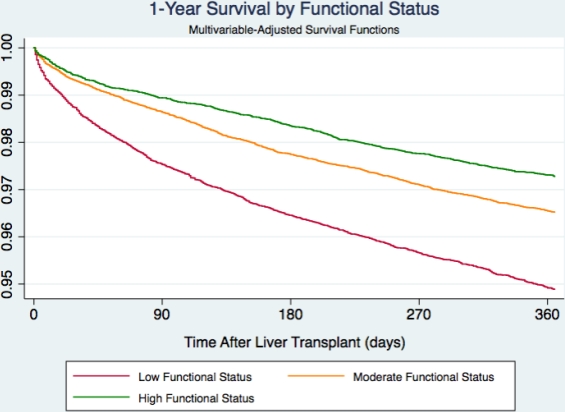Functional Status Predicts Mortality After Liver Transplant
1Surgery, UMass Memorial Medical Center, Worcester, MA
2Quantitative Health Sciences, University of Massachusetts Medical School, Worcester, MA.
Meeting: 2015 American Transplant Congress
Abstract number: 269
Keywords: Liver failure, Mortality, Outcome, Risk factors
Session Information
Session Name: Concurrent Session: Donor and Recipient Optimization for Liver Transplant
Session Type: Concurrent Session
Date: Monday, May 4, 2015
Session Time: 4:00pm-5:30pm
 Presentation Time: 4:00pm-4:12pm
Presentation Time: 4:00pm-4:12pm
Location: Room 115-AB
Purpose: To investigate whether pre-transplant functional status predicts mortality after liver transplant (LT).
Methods: We conducted a retrospective cohort study of first-time adult LT recipients using the Scientific Registry of Transplant Recipients (January 2006–October 2011). We used the 3-tiered Karnofsky Performance Status Scale. Life tables and Cox proportional hazards were used for survival analysis.
Results: Our sample included 24,505 subjects with a mean age of 54.6 years and mean MELD of 20.2. The proportion of patients that were Low functional status increased over the course of the study period from 20.3% to 32.1% (p<0.001). Overall, one-quarter of our sample was of Low functional status, 43.5% were Moderate, and 30.5% were High. Women, Hispanic/Latinos, and Medicaid-insured patients were more likely to be of lower functional status. Over one-third (36.9%) of Low functional status patients had a MELD score of < 26. Survival at 1 year was 88.2%, and this rate was lower among Low (81.8%) compared with High (91.9%) functional status patients. After adjusting for key recipient and donor variables (recipient age/sex/race, BMI, diabetes, prior abdominal surgery, Hepatitis C, MELD, medical condition, portal vein thrombosis, donor age, DCD donor, cold ischemia time), patients that were of Low (Hazard Ratio (HR)) 1.34, 95% Confidence Interval (CI) 1.22–1.47) or Moderate (HR 1.18, 95%CI 1.11–1.26) functional status were at increased risk for dying compared with High functional status patients. Upon multivariate-adjusted subpopulation analysis of non-critical, low MELD (<26) patients (n=17,609), the HRs were 1.43 (95%CI 1.28–1.60) for Low and 1.17 (95%CI 1.09–1.26) for Moderate, as compared to High, functional status patients.
Conclusion: Pre-transplant functional status is a valuable prognostic indicator of post-LT mortality. Functional status provides insight into global health status and may assist providers in management and decision-making for LT candidates and recipients. Further research on the course of functional status decline and potential for interventions is warranted. 
To cite this abstract in AMA style:
Dolgin N, Martins P, Anderson F, Bozorgzadeh A. Functional Status Predicts Mortality After Liver Transplant [abstract]. Am J Transplant. 2015; 15 (suppl 3). https://atcmeetingabstracts.com/abstract/functional-status-predicts-mortality-after-liver-transplant/. Accessed December 3, 2025.« Back to 2015 American Transplant Congress
